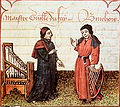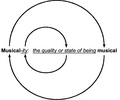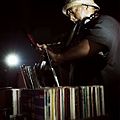Portal maintenance status: (April 2020)
|
The Music Portal
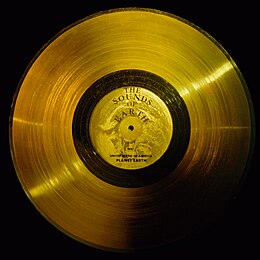
Music is the arrangement of sound to create some combination of form, harmony, melody, rhythm, or otherwise expressive content. Music is generally agreed to be a cultural universal that is present in all human societies. Definitions of music vary widely in substance and approach. While scholars agree that music is defined by a small number of specific elements, there is no consensus as to what these necessary elements are. Music is often characterized as a highly versatile medium for expressing human creativity. Diverse activities are involved in the creation of music, and are often divided into categories of composition, improvisation, and performance. Music may be performed using a wide variety of musical instruments, including the human voice. It can also be composed, sequenced, or otherwise produced to be indirectly played mechanically or electronically, such as via a music box, barrel organ, or digital audio workstation software on a computer.
Music often plays a key role in social events and religious ceremony. The techniques of making music are often transmitted as part of a cultural tradition. Music is played in public and private contexts, highlighted at events such as festivals and concerts for various different types of ensembles. Music is used in the production of other media, such as in soundtracks to films, TV shows, operas, and video games.
Listening to music is a common means of entertainment. The culture surrounding music extends into areas of academic study, journalism, philosophy, psychology, and therapy. The music industry includes songwriters, performers, sound engineers, producers, tour organizers, distributors of instruments, accessories, and publishers of sheet music and recordings. Technology facilitating the recording and reproduction of music has historically included sheet music, microphones, phonographs, and tape machines, with playback of digital musics being a common use for MP3 players, CD players, and smartphones. (Full article...)
General images - load new batch
-
Image 1A musician in a recording studio (from Music industry)
-
Image 2The Bull Headed Lyre of Ur, found in the Royal Cemetery at Ur, is the best known of the ancient Lyres of Ur (from History of music)
-
Image 5Frances Densmore at the Smithsonian Institution in 1916 where she was recording Blackfoot chief Mountain Chief for the Bureau of American Ethnology. In this picture, Mountain Chief is listening to a recording. (from Music industry)
-
Image 6Sheet music for part of the Missa Papae Marcelli by Giovanni Pierluigi da Palestrina (from History of music)
-
Image 8The Beatles (1964) have been credited by music historians for heralding the album era. (from Album era)
-
Image 10The Japanese boy band Arashi, who had the world's best-selling album (5x20 All the Best!!) in 2019 (from Album era)
-
Image 12The monumental Bianzhong of Marquis Yi of Zeng, c. 5th century BCE, from Hubei (from History of music)
-
Image 14Guillaume Du Fay (left), with Gilles Binchois (right) in a c. 1440 Illuminated manuscript copy of Martin le Franc's Le champion des dames (from History of music)
-
Image 16Terracotta statue of a Parthian lute player (from History of music)
-
Image 17Two musicians of the Eastern Han Dynasty (25–220 CE), Shanghai Museum (from History of music)
-
Image 19Taylor Swift, a longtime adherent to album-era rollouts, surprise-released her albums instead in 2020. (from Album era)
-
Image 21A radio broadcasting system from 1906 (from Music industry)
-
Image 22US vinyl sales in units, 1995–2020; while album sales overall declined, those in the vinyl format rose toward the end of the 2010s. (from Album era)
-
Image 23Drawing of the tablet with the Hymn to Nikkal (c. 1400 BCE), the oldest of the Hurrian songs (from History of music)
-
Image 24Platinum records by Elvis Presley, Prince, Madonna, Lynyrd Skynyrd, and Bruce Springsteen, at Julien's Auctions (from Album era)
-
Image 27The logo for Apple Inc.'s online iTunes store, which sells digital files of songs and musical pieces–along with a range of other content, such as digital files of TV shows and movies (from Music industry)
-
Image 28c. 379 CE Bas relief of Sassanid women playing the chang in Taq-e Bostan, Iran (from History of music)
-
Image 30As LPs fell out of favor to CDs, hip hop producers repurposed them as sampling sources, contributing to the development of record collecting. (from Album era)
-
Image 32An example of mechanically printed sheet music (from Music industry)
-
Image 35A young man browsing through a record store in Bonn, West Germany, June 1988 (from Album era)
-
Image 37Kanye West (2007) emerged during the decade as an important hip-hop producer and album artist. (from Album era)
-
Image 39Pink Floyd (1973) performing The Dark Side of the Moon, a leading commercial success of the LP era (from Album era)
-
Image 40Notation indicating differing pitch, dynamics, articulation, and instrumentation (from Elements of music)
 Featured articles - load new batch
Featured articles - load new batch
-
Image 1"Paranoid Android" is a song by English alternative rock band Radiohead, released as the lead single from their third studio album, OK Computer (1997), on 26 May 1997. The lyrics were written by singer Thom Yorke following an unpleasant experience in a Los Angeles bar. The song is over six minutes long and contains four sections. The name is taken from Marvin the Paranoid Android from the science fiction series The Hitchhiker's Guide to the Galaxy.
"Paranoid Android" charted at number three on the UK Singles Chart, Radiohead's highest-charting position in the UK to date. It received acclaim, with critics claiming it to be the band's magnum opus, comparing it to the songs "Happiness Is a Warm Gun" by the Beatles and "Bohemian Rhapsody" by Queen. It has appeared regularly on lists of the best songs of all time, including NME's and Rolling Stone's respective 500 Greatest Songs of All Time lists. Its animated music video, directed by Magnus Carlsson, was placed on heavy rotation on MTV, although the network censored portions containing nudity in the US. At the 1998 Brit Awards, the song was nominated for Best British Single. The track has been covered by artists in a variety of genres. It was included in the 2008 Radiohead: The Best Of. (Full article...) -
Image 2"Hot Sugar" is a song by American singer Tamar Braxton from her second studio album, Love and War (2013). Kyle "K2" Stewart II produced the song and co-wrote it with Braxton, LaShawn Daniels, and Makeba Riddick. The lyrics focus on maintaining a relationship. Music critics variously interpreted the song as having club, dance, or hip hop influences. "Hot Sugar" was planned to be the lead single from Love and War before it was replaced by the album's title track, which performed better on radio. Some reviewers praised "Hot Sugar" for its uptempo production; others criticized it as inferior to the rest of the album, specifically the ballads.
The music video for "Hot Sugar" was directed by photographers Steven Gomillion and Dennis Leupold and features Braxton along with male dancers on Tamartiangram, a spoof of Instagram. Shortly after the video's release, Braxton said the directors had abandoned it mid-production to work on Rihanna's Diamonds World Tour. "Hot Sugar" was featured on the reality television shows Braxton Family Values and Tamar & Vince. Braxton further promoted the song through live performances, including on her Love and War Tour in 2014. The track peaked at number 15 on Billboard's Bubbling Under Hot 100 chart and number 48 on the Hot R&B/Hip-Hop Songs chart. (Full article...) -
Image 3"Sweetheart" is a song originally recorded by American singer Rainy Davis. It was written by Davis and Pete Warner, and produced with Dorothy Kessler. The track was released in 1986 by independent record label SuperTronics as a single from Davis's 1987 studio album Sweetheart. A freestyle, hip hop pop, and synth-funk song, "Sweetheart" appeared on R&B and dance music-based record charts in the United States.
American singer Mariah Carey recorded a cover version with American rapper Jermaine Dupri (credited as JD) for his debut album, Life in 1472 (1998), and her first greatest hits album, #1's (1998). So So Def and Columbia Records released it as the third single from the former album on September 7, 1998. Carey was inspired to create a remake of "Sweetheart" as she liked listening to the song as a teenage girl. Critics categorized the cover as a dance, hip-hop, and R&B song, and its instrumental features synths and bass runs. The lyrics describe a woman's desire for a person with whom to share a romance. (Full article...) -
Image 4Pru is the debut studio album by American singer Pru. It was released on November 7, 2000, through Capitol Records. Pru was managed by Capitol Records executive Roy Lott, who had signed Pru to Warner/Chappell Music Publishing after being impressed by her songwriting and voice on a demo tape. Pru collaborated with Ben Garrison, the Characters, and Rick Williams on the album.
According to Lott, Pru was part of Capitol Records' attempts to attract a wider audience through her crossover appeal. According to music critics, the album encompasses several genres, with some commentators noting influences from neo soul. Pru also used poetry as an inspiration for writing music. (Full article...) -
Image 5Smiley Smile is the twelfth studio album by the American rock band the Beach Boys, released on September 18, 1967. Conceived as a simpler and more relaxed version of their unfinished Smile album, Smiley Smile is distinguished for its homespun arrangements, "stoned" aesthetic, and lo-fi production. Critics and fans generally received the album and its lead single, "Heroes and Villains", with confusion and disappointment. The album reached number 9 on UK record charts, but sold poorly in the U.S., peaking at number 41—the band's lowest chart placement to that point.
Following principal songwriter Brian Wilson's declaration that most of the original Smile tapes would be abandoned, the majority of the recording sessions lasted for six weeks at his makeshift home studio using radio broadcasting equipment, a detuned piano, electronic bass, melodica, found objects for percussion, and a Baldwin theater organ. The unconventional recording process juxtaposed an experimental party-like atmosphere with short pieces of music edited together in a disjointed manner, combining the engineering methods of "Good Vibrations" (1966) with the loose feeling of Beach Boys' Party! (1965). Despite leading these sessions, Wilson deliberately credited the album's production to the group collectively for the first time. (Full article...) -
Image 6Romance is the eighth studio album by Mexican singer Luis Miguel. It was released by WEA Latina on 19 November 1991. Although the production was originally intended as another collaboration with Juan Carlos Calderón, that plan was scrapped when Calderón was unable to compose songs for the album. Facing a new-material deadline in his recording contract, at his manager's suggestion Miguel chose bolero music for his next project. Mexican singer-songwriter Armando Manzanero was hired by WEA Latina to co-produce the album with Miguel. Recording began in August 1991 at Ocean Way Recording in Hollywood, California, with Bebu Silvetti the arranger.
On the album Miguel covers twelve boleros, originally recorded from 1944 to 1986. The first two singles, "Inolvidable" and "No Sé Tú", reached number one on the Billboard Hot Latin Songs chart in the United States and spent six months atop the Mexican charts. "Mucho Corazón" and "Cómo" were in the top five of the Hot Latin Songs chart, and "Usted" and "La Barca" received airplay throughout Latin America. Miguel promoted the record with a tour of the United States and Latin America. The album was generally well received by music critics, who praised Miguel's singing and the record's production. The singer received several accolades, including a Grammy nomination for Best Latin Pop Album. (Full article...) -
Image 7Dilwale Dulhania Le Jayenge (transl. The Brave-Hearted Will Take the Bride), also known by the initialism DDLJ, is a 1995 Indian Hindi-language musical romance film written and directed by Aditya Chopra in his directorial debut and produced by his father Yash Chopra. Released on 20 October 1995, the film stars Shah Rukh Khan and Kajol as Raj and Simran, two young non-resident Indians, who fall in love during a vacation through Europe with their friends. Raj tries to win over Simran's family so the couple can marry, but Simran's father has long since promised her hand to his friend's son. The film was shot in India, London, and Switzerland, from September 1994 to August 1995.
With an estimated total gross of ₹102.5 crore (today's adjusted gross ₹524 crore), with ₹89 crore (today's adjusted gross ₹455 crore) earned in India and ₹13.50 crore (today's adjusted gross ₹69 crore) in overseas. The film Dilwale Dulhania Le Jayenge was the highest-grossing Indian film of 1995 and one of the most successful Indian films in history. When adjusted for inflation, it is the second highest-grossing Indian film of the 1990s, behind Hum Aapke Hain Koun..! It won 10 Filmfare Awards—the most for a single film at that time—and the National Film Award for Best Popular Film Providing Wholesome Entertainment. Its soundtrack album became one of the most popular of the 1990s. (Full article...) -
Image 8"Halo" is a song recorded by American singer and songwriter Beyoncé for her third studio album, I Am... Sasha Fierce (2008). Included on the I Am... disc, it was intended to give a behind-the-scenes glimpse of Beyoncé's life, stripped of her make-up and celebrity trappings. Columbia Records released the song, the album's fourth single, to mainstream radio in the United States on January 20, 2009, and to international markets from February 20. Inspired by Ray LaMontagne's 2004 song "Shelter", "Halo" was written by Ryan Tedder and Evan Bogart, with the former producing it alongside Beyoncé, who handled the vocal production. It was originally conceived by Tedder and Bogart specifically for Beyoncé, although there was media speculation that it had been intended for Leona Lewis.
"Halo" is a pop and R&B power ballad, the lyrics of which describe a sublime love. It features drum, piano, keyboard, string, synthesizer, and percussion instrumentation. The song faced a controversy when Kelly Clarkson claimed that Tedder had reused the musical arrangement in her own 2009 song "Already Gone". "Halo" received positive reviews from music critics, who made comparisons with Lewis's 2007 song "Bleeding Love", also written by Tedder. Its production and Beyoncé's vocals also received critical praise. "Halo" was nominated for Record of the Year and won Best Female Pop Vocal Performance at the 52nd Annual Grammy Awards. It won Best Song at the 2009 MTV Europe Music Awards. (Full article...) -
Image 9The Seduction of Ingmar Bergman is the 22nd album by American rock group Sparks, released in August 2009. The duo's first work in the radio musical genre, the album is built around an imaginary visit to Hollywood by Swedish film director Ingmar Bergman in the mid-1950s. Its storyline focuses on the divides between European and American culture, between art and commerce. Unlike other Sparks albums, the work is conceived as a single piece, to be listened to as a whole, rather than a collection of stand-alone songs.
The work was commissioned by Sveriges Radio Radioteatern, the radio drama department of Sweden's national radio broadcaster. First released in the Swedish broadcast version in August 2009, with an English-language version following in November 2009, it features a cast of Swedish and American actors and a variety of musical styles ranging from opera to vaudeville and pop. The album's recording was a collaborative effort – while the music and English vocals were recorded by Sparks in the United States, the album's Swedish vocals were recorded by Sveriges Radio in Stockholm, and then sent to the Maels via an FTP server. The album and its ambitious dramatic concept received favourable reviews and spawned both a live show and plans to turn it into a film. (Full article...) -
Image 10Poster promoting the band's 6 July concert at the Honolulu International Center
The English rock band the Kinks staged their first concert tour of the United States in June and July 1965. The sixteen concerts comprised the third stage of a world tour, following shows in Australasia, Asia and in the United Kingdom and before later stages in continental Europe. Initially one of the most popular British Invasion groups, the Kinks saw major commercial opportunity in the US, but the resultant tour was plagued with issues between the band, their management, local promoters and the American music unions. Promoters and union officials filed complaints over the Kinks' conduct, prompting the US musicians' union to withhold work permits from the band for the next four years, effectively banning them from US performance.
The programme was in the package-tour format typical of the 1960s, with one show per day, several support acts on the bill and the Kinks' set lasting around 40 minutes. Concerts were characterised by screaming fans and weak sound systems. The US press, which still largely viewed rock music as simple teenage entertainment, generally avoided reporting on the tour. Some shows were poorly attended, owing to a lack of advertising and promotion, leaving local promoters sometimes unable to pay the band the full amount they were due. A payment disagreement led to the band refusing to perform at the Cow Palace near San Francisco, and an argument over a union contract before a television appearance resulted in Ray Davies, the Kinks' bandleader, physically fighting with a union official. (Full article...) -
Image 11
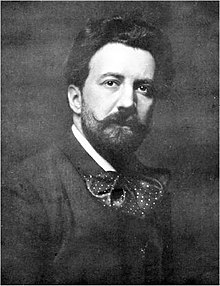
Portrait by Ernest Walter Histed, c. 1906
Sir Henry Joseph Wood CH (3 March 1869 – 19 August 1944) was an English conductor best known for his association with London's annual series of promenade concerts, known as the Proms. He conducted them for nearly half a century, introducing hundreds of new works to British audiences. After his death, the concerts were officially renamed in his honour as the "Henry Wood Promenade Concerts", although they continued to be generally referred to as "the Proms".
Born in modest circumstances to parents who encouraged his musical talent, Wood started his career as an organist. During his studies at the Royal Academy of Music, he came under the influence of the voice teacher Manuel García and became his accompanist. After similar work for Richard D'Oyly Carte's opera companies on the works of Arthur Sullivan and others, Wood became the conductor of a small operatic touring company. He was soon engaged by the larger Carl Rosa Opera Company. One notable event in his operatic career was conducting the British premiere of Tchaikovsky's Eugene Onegin in 1892. (Full article...) -
Image 12"Alejandro" is a song by American singer Lady Gaga from her third extended play (EP), The Fame Monster (2009)—the reissue of her debut studio album, The Fame (2008). Written and produced by Gaga and RedOne, it was released on April 20, 2010, as the third single from the EP. Interscope Records intended the track "Dance in the Dark" to be the EP's third single after "Alejandro" initially received limited airplay, but Gaga insisted on the latter. A synth-pop track with Europop and Latin pop beats, it opens with a sample from the main melody of Vittorio Monti's "Csárdás". The song was inspired by Gaga's fear of men and is about her bidding farewell to her Latino lovers named Alejandro, Roberto and Fernando.
Some critics praised the track's catchiness and production while others criticized it as unoriginal, mainly due to the influence from the pop acts ABBA and Ace of Base. Retrospective reviewers ranked the song as one of Gaga's best. Following the album's release, the song charted in the UK and Hungary. Upon its release as a single, "Alejandro" topped the Czech, Finnish, Greek, Mexican, Venezuelan, Polish, Russian and Romanian charts, and reached the top five in the US, Australia, Canada and Sweden. In a 2017 journal, which studied structural patterns in melodies of earworm songs, American Psychological Association called "Alejandro" one of the catchiest in the world. (Full article...) -
Image 13
Not My Responsibility is a 2020 American short film written and produced by singer-songwriter Billie Eilish. A commentary on body shaming and double standards placed upon young women's appearances, it features a monologue from Eilish about the media scrutiny surrounding her body. The film is spoken-word and stars Eilish in a dark room, where she gradually undresses before submerging herself in a black substance.
The film premiered during Eilish's Where Do We Go? World Tour on March 9, 2020, as a concert interlude, and was released online on May 26, 2020. Critics gave positive reviews, praising the commentary and tone, which they considered empowering. The film's audio was later included as a song on Eilish's second studio album, Happier Than Ever (2021). Some music journalists described it as the album's thematic centerpiece; others questioned its appearance on the tracklist, feeling that it lost its emotional impact without the visuals. (Full article...) -
Image 14Body Count is the debut studio album by American heavy metal band Body Count, released on March 10, 1992, by Sire Records. The album's material focuses on various social and political issues ranging from police brutality to drug abuse. It also presents a turning point in the career of Ice-T, who co-wrote the album's songs with lead guitarist Ernie C and performed as the band's lead singer. Previously known only as a rapper, Ice-T's work with the band helped establish a crossover audience with rock music fans. The album produced the single "There Goes the Neighborhood".
Body Count is well known for the inclusion of the controversial song "Cop Killer", which was the subject of much criticism from various political figures, although many defended the song on the basis of the group's right to freedom of speech. Ice-T eventually chose to remove the song from the album, although it continues to be performed live. It was voted the 31st best album of the year in The Village Voice's Pazz & Jop critics poll, and is believed to have helped pave the way for the mainstream success of the rap metal genre. (Full article...) -
Image 15
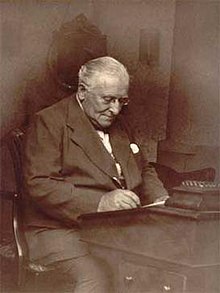
Albert William Ketèlbey (/kəˈtɛlbi/; born Ketelbey; 9 August 1875 – 26 November 1959) was an English composer, conductor and pianist, best known for his short pieces of light orchestral music. He was born in Birmingham and moved to London in 1889 to study at Trinity College of Music. After a brilliant studentship he did not pursue the classical career predicted for him, becoming musical director of the Vaudeville Theatre before gaining fame as a composer of light music and as a conductor of his own works.
For many years Ketèlbey worked for a series of music publishers, including Chappell & Co and the Columbia Graphophone Company, making arrangements for smaller orchestras, a period in which he learned to write fluent and popular music. He also found great success writing music for silent films until the advent of talking films in the late 1920s. (Full article...)
Selected pictures
-
Image 1Photo credit: New York World-Telegram and SunLouis Armstrong, nicknamed "Satchmo" or "Pops", was an American jazz trumpeter and singer. Armstrong was a foundational influence on jazz, shifting the music's focus from collective improvisation to solo performers. With his distinctive gravelly voice, Armstrong was also an influential singer, demonstrating great dexterity as an improviser and as a scat singer.
-
Image 2Photograph credit: Fritz Luckhardt; restored by Adam CuerdenJohann Strauss II (25 October 1825 – 3 June 1899) was an Austrian composer of light music, particularly dance music and operettas. Part of the Strauss dynasty, his father demanded that none of his sons pursue music as a career, despite their display of musical talent. It was only after his father had abandoned the family for a mistress that the younger Strauss was able to develop his skills as a composer, with the encouragement of his mother. He eventually attained greater fame than his father, and became one of the most popular waltz composers of the era, conducting extensive tours of Austria, Poland and Germany with his orchestra.
-
Image 3Elvis Presley meets Richard NixonPhotograph: Oliver F. AtkinsAmerican singer Elvis Presley meeting then-president Richard Nixon on December 21, 1970. During the meeting, the singer expressed his patriotism and his contempt for hippies, the growing drug culture, and the counterculture in general. Presley then asked Nixon for a Bureau of Narcotics and Dangerous Drugs badge, to signify official sanction of his patriotic efforts. Nixon gave Presley the badge and expressed a belief that Presley could send a positive message to young people and that it was therefore important he retain his credibility.
-
Image 4Photograph credit: Carl Van Vechten; restored by Adam CuerdenWilliam Grant Still (1895–1978) was an American composer of nearly 200 works, including five symphonies and nine operas. Often referred to as the "Dean of Afro-American Composers", Still was the first American composer to have an opera produced by the New York City Opera. His first symphony, entitled Afro-American Symphony, was until 1950 the most widely performed symphony composed by an American. Born in Mississippi, he grew up in Little Rock, Arkansas, attended Wilberforce University and Oberlin Conservatory of Music, and was a student of George Whitefield Chadwick and later Edgard Varèse. Still was the first African American to conduct a major American symphony orchestra and the first to have an opera performed on national television. Due to his close association and collaboration with prominent African-American literary and cultural figures, he is considered to be part of the Harlem Renaissance movement.
This picture of Still was taken by Carl Van Vechten in 1949; the photograph is in the collection of the Library of Congress in Washington, D.C. -
Image 5Photograph credit: Jean Reutlinger; restored by Adam CuerdenNelly Martyl (1884–1953) was a French opera singer. She sang in the premieres of several operas, including Leborne's La Catalane (1907), Erlanger's La Sorcière (1912), and Massenet's Amadis (1922). Martyl joined the Red Cross as a nurse during the First World War, and served at the Battle of Verdun in 1916, where she was known as la fée de Verdun (the Fairy of Verdun), and at the Second Battle of the Aisne in 1917. She continued as a nurse after the war to help with the 1918 epidemic of Spanish flu. She was awarded the Croix de Guerre with the carte du combattant (signifying service under particular hazard) in 1920.
-
Image 6Illustration credit: Carlos Schwabe; restored by Adam CuerdenFervaal is an opera with a prologue and three acts by the French composer Vincent d'Indy. Fervaal is the son of a Celtic king and is destined to be the last advocate of the old gods. His mission is to save his homeland from invasion and pillage, but in doing so he must renounce love. This illustration, by the Swiss painter Carlos Schwabe, relates to the 10 May 1898 premiere of the opera at the Théâtre de l'Opéra-Comique in Paris. Here, Fervaal is depicted ascending a mountain while carrying the body of his beloved Guilhen at the end of the opera, as the pagan gods and their worshippers fade out of existence with the dawn of Christianity.
-
Image 7Illustration credit: unknownAriadne auf Naxos ('Ariadne on Naxos'), Op. 60, is an opera by Richard Strauss with a German libretto by Hugo von Hofmannsthal. Combining slapstick comedy and consummately beautiful music, the opera's theme is the competition between high and low art for the public's attention. The opera was originally conceived as a 30-minute divertissement to be performed at the end of Hofmannsthal's adaptation of Molière's play Le Bourgeois gentilhomme. Besides the opera, Strauss provided incidental music to be performed during the play. In the end, the opera was ninety minutes long, and the performance of the play and opera together totalled over six hours. It was first performed at the Staatsoper Stuttgart on 25 October 1912, directed by Max Reinhardt. The combination of the play and opera proved to be unsatisfactory to the audience: those who had come to hear the opera resented having to wait until the play finished. The work was revised in 1916, with the play being replaced by a prologue, and first performed at the Vienna State Opera on 4 October of that year.
This picture is the cover of a vocal score of the revised edition of Ariadne auf Naxos, published in 1916. -
Image 8Photograph credit: Carl Van Vechten; restored by Adam CuerdenBessie Smith (April 15, 1894 – September 26, 1937) was an American blues singer widely renowned during the Jazz Age. She is often regarded as one of the greatest singers of her era and was a major influence on fellow blues singers, as well as jazz vocalists.
Born in Chattanooga, Tennessee, her parents died when Smith was young, and she and her sister survived by performing on the streets of Chattanooga, Tennessee. She began touring and performed in a group that included Ma Rainey, and then went out on her own. Her successful recording career began in the 1920s, until an automobile accident ended her life at age 43. -
Image 9Lina Rafn (b. 1976) is a Danish singer, songwriter and producer active with the band Infernal. She had previously been a VJ on the show The Voice TV Danmark.
-
Image 10Photograph: Achim RaschkaSimon Neil (b. 1979) is a Scottish vocalist, guitarist, and songwriter. Born in Irvine, he established the band Biffy Clyro in 1995 with James and Ben Johnston. He has also played with JP Reid of Sucioperro in Marmaduke Duke, using the pseudonym "The Atmosphere", and started a solo career.
-
Image 11Photo: W. J. Mayer; Restoration: Lise BroerA bust of the German composer and pianist Ludwig van Beethoven (1770–1827), made from his death mask. He was a crucial figure in the transitional period between the Classical and Romantic eras in Western classical music, and remains one of the most acclaimed and influential composers of all time. Born in Bonn, of the Electorate of Cologne and a part of the Holy Roman Empire of the German Nation in present-day Germany, he moved to Vienna in his early twenties and settled there, studying with Joseph Haydn and quickly gaining a reputation as a virtuoso pianist. His hearing began to deteriorate in the late 1790s, yet he continued to compose, conduct, and perform, even after becoming completely deaf.
-
Image 12Hera is an Icelandic singer-songwriter who emigrated to New Zealand as a teenager. She is known for her facial art, which is "inspired by moko and also by Celtic warrior paint" and intended to represent both her Icelandic and New Zealand heritage. In 2002 she was named Best Female Singer at the Icelandic Music Awards.
-
Image 13Photograph credit: unknown; restored by Adam CuerdenSamuel Coleridge-Taylor (15 August 1875 – 1 September 1912) was an English composer and conductor. His greatest success was his cantata Hiawatha's Wedding Feast. This set the epic poem The Song of Hiawatha by Henry Wadsworth Longfellow to music, and was widely performed by choral groups in England and the United States. Composers were not well paid; the work sold hundreds of thousands of copies, but he had sold the music outright for the sum of 15 guineas, so did not benefit directly. He learned to retain his rights and earned royalties for other compositions after achieving wide renown, but always struggled financially. This photograph of Coleridge-Taylor was taken around 1905.
-
Image 14Photo: Benoît Derrier; edit: KeraunoscopiaAne Brun (b. 1976) is a Norwegian songwriter, guitarist and vocalist. She has recorded eight albums, starting in 2003 with Spending Time with Morgan.
-
Image 15Alexz Johnson (b. 1986) is a Canadian singer-songwriter and actress, best known for roles as Jude Harrison in the CTV series Instant Star (character shown here), Annie Thelan in the Disney Channel series So Weird, and as Erin Ulmer in the 2006 horror film Final Destination 3. Her album Voodoo was released in 2010.
Related portals
Did you know (auto-generated)

- ... that Max Weil, founder of the Halifax Symphony Orchestra, spent his later years in real estate?
- ... that a will bequeathing the Chestnut Street Opera House to the University of Pennsylvania was contested at the Supreme Court of Pennsylvania?
- ... that husband and wife Edward M. and Marie Zimmerman co-wrote the suffragist anthem "Votes for Women: Suffrage Rallying Song"?
- ... that Wilner Burke was the director of the Lumberjack Band, the marching band of the Green Bay Packers, for 42 years?
- ... that Steve Elcock's Symphony No. 6 is dedicated to "the everlasting execration of self-serving politicians, the obscenely rich and the system that allows them to remain so"?
- ... that Oksana Lyniv founded the Youth Symphony Orchestra of Ukraine in 2016 and conducted them in thirty concerts across ten music festivals in 2022?
- Birthdays in Music: September 20
- Chuck Panozzo, American guitarist with Styx, turns 76.
- John Harle, Brit composer and soprano saxophonist, turns 68.
- Alannah Currie, New Zealand vocalist and saxophonist with The Thompson Twins, turns 67.
- Nuno Bettencourt, American guitarist with Extreme, turns 58.
- Matthew Nelson, American bassist for glam metal band, Nelson, turns 57.
- Gunnar Nelson, American lead vocalist for glam metal band, Nelson, turns 57.
- Ben Shepherd, American bassist with Soundgarden , turns 56.
- Namie Amuro, Japanese j-pop singer, turns 47.
- Sarit Hadad, Israeli singer, turns 46.
- Rick Woolstenhulme, American drummer with Lifehouse, turns 45.
Categories
Explore
Connections
WikiProjects connected with music: WikiProject Music – Songs – Albums – Alternative music - Classical music – Composers – Contemporary Christian music – Contemporary music – Electronic music – Emo music – Hip hop – Instruments – Led Zeppelin - Metal music – Jazz – Musicians – Opera – Panic at the Disco – Powderfinger (band) – Punk music – Record Labels – Record Production – Rock music – R&B and Soul Music – Terminology – The Beatles
Create a requested article: See the list of Requested articles.
Improve an article: See the Music Noticeboard for a list of tasks.
Start a music course: School of Music at Wikiversity
Associated Wikimedia
The following Wikimedia Foundation sister projects provide more on this subject:
-
Commons
Free media repository -
Wikibooks
Free textbooks and manuals -
Wikidata
Free knowledge base -
Wikinews
Free-content news -
Wikiquote
Collection of quotations -
Wikisource
Free-content library -
Wikispecies
Directory of species -
Wikiversity
Free learning tools -
Wikivoyage
Free travel guide -
Wiktionary
Dictionary and thesaurus













